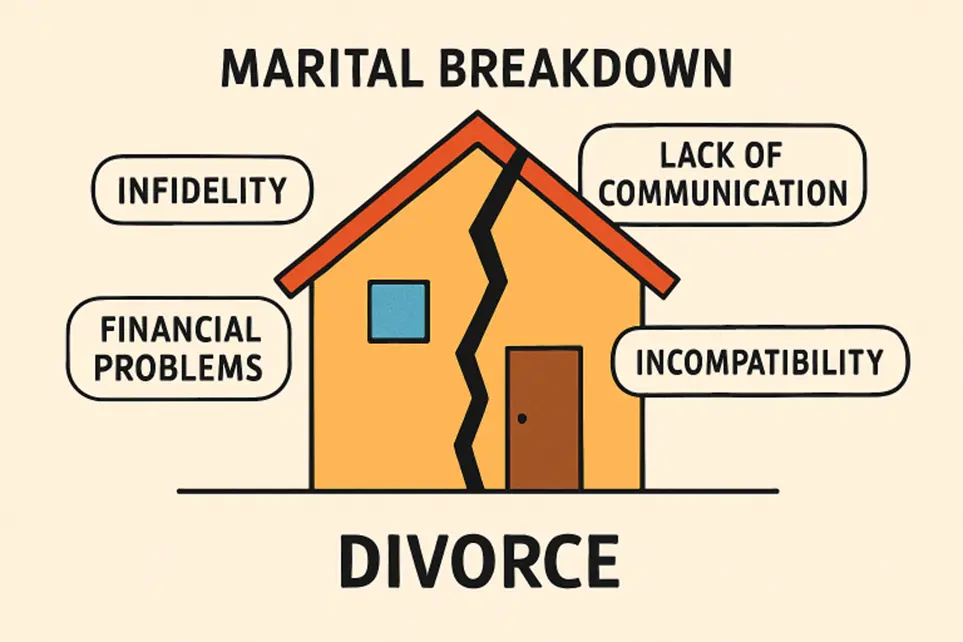Top Reasons Couples Choose to Divorce
Marriage is often regarded as one of life’s most meaningful and profound partnerships. It brings together two individuals who, at least initially, choose to combine their lives, dreams, and futures. However, this union, for all its promise, can also bring with it a host of challenges. These challenges sometimes become so significant that couples find themselves facing the possibility or reality of divorce. In the United States, diverse factors influence why couples part ways, and understanding these reasons is crucial for anyone striving to build a marriage that withstands the test of time. Even the legal context, such as the grounds for divorce in Texas Family Code, can impact how and why couples decide to separate. This underscores that both local factors—like state laws—and deeply personal experiences all play a part in the outcome of a marriage and the decisions surrounding divorce.
The reasons why marriages fail are as varied as the couples themselves, ranging from emotional and psychological struggles to practical and financial obstacles. Some couples are blindsided by issues that arise suddenly, while others watch problems slowly fester over the years. By examining the most common triggers for marital breakdown, we not only gain a clearer understanding of why relationships fall apart, but we also empower couples with the knowledge to recognize warning signs and address them before it’s too late. Taking a proactive approach—learning about and discussing these issues—can help couples establish healthier foundations and seek professional help or counseling if necessary. Read on for a comprehensive look at the primary factors most often associated with divorce, along with actionable insights to help you nurture and protect your relationship for years to come.
Lack of Commitment
Commitment lies at the heart of every long-lasting marriage. It’s more than just saying “I do”—it involves making daily choices to support, cherish, and remain present for your partner. When one or both partners begin to withdraw their investment in the relationship, the effects are often profound. Studies from the National Fatherhood Initiative reveal that 73% of participants listed lack of commitment as a top reason for divorce. This lack typically manifests as an unwillingness to collaborate on solving problems or a gradual withdrawal from shared activities. Over time, partners can start to feel isolated or unsupported, which erodes the sense of partnership essential to any marriage. While not all couples who struggle with commitment are destined for divorce, recognizing early signs—like increasing emotional distance or avoidance of joint decision-making—can be vital in preventing relationship breakdown. Investing in communication, finding shared interests, and seeking counseling if needed are just a few ways couples can rekindle and strengthen their commitment.
Infidelity
For many, infidelity represents an almost irreparable breach of trust. Cheating can shatter the security and faith that are central to a marriage, often leaving deep emotional scars. While infidelity is sometimes the final straw, it usually signals preexisting problems in the relationship, such as neglect, unmet needs, or ongoing conflict. According to data from the American Association for Marriage and Family Therapy, about 15% of married women and 25% of married men have had extramarital affairs. The sense of betrayal, compounded by feelings of rejection or inadequacy, can make it incredibly difficult for couples to rebuild their relationship, even with the help of counseling. Preventing infidelity often requires both partners to be proactive in meeting each other’s emotional and physical needs while also regularly discussing boundaries and expectations. Open communication about struggles or temptations can help create a safe environment, making it more likely for problems to be addressed before they escalate into acts of betrayal.
Financial Incompatibility
Disagreements over money can be some of the most persistent and destructive issues a couple faces. Whether the conflict revolves around spending habits, saving strategies, career choices, or attitudes toward debt, financial discord often becomes a battleground where larger issues are played out. The Institute for Divorce Financial Analysts notes that financial incompatibility is cited as a primary reason for divorce by roughly 24% of divorcing couples. For some, widely divergent views about money management create constant stress or drive a wedge of resentment. For others, unforeseen hardships—like job loss or medical expenses—amplify existing vulnerabilities within the partnership. Effective money management in marriage isn’t just about math; it’s about values, trust, and cooperation. Couples who manage to construct openly shared budgets, discuss financial goals regularly, and collaborate on major purchases are more likely to develop a resilient and united approach to economic challenges.
Constant Conflict and Arguing
While it’s normal for couples to disagree, frequent or unresolved arguments can quickly poison a relationship. A pattern of negative communication—such as yelling, sarcasm, stonewalling, or bringing up past grievances—makes it difficult for couples to resolve issues and move forward. In fact, 57% of individuals pointed to ongoing conflict as a significant factor in their divorce. When conflict is not handled constructively, it creates a hostile environment where love, trust, and intimacy cannot thrive. Couples who invest in learning healthy communication skills, possibly with the help of a therapist, stand a greater chance of breaking cycles of conflict. Opening up about feelings, validating each other’s perspectives, and focusing on problem-solving rather than blame can transform arguments into opportunities for growth and deepened understanding.
Substance Abuse
Struggling with addiction is a heavy burden both for the afflicted person and for their spouse. Substance abuse—whether it involves alcohol, illegal drugs, or prescription medications—can destabilize every aspect of family life. Trust can erode quickly, financial stability often suffers, and the emotional distance widens as the addicted partner becomes increasingly consumed by their dependency. Substance abuse is consistently listed among the leading reasons for divorce. Over time, the accompanying dishonesty, erratic behavior, and neglect may make it impossible for the marriage to survive without significant intervention. In cases where couples do want to recover, professional treatment programs, counseling, and strong external support networks are essential. For others, prioritizing personal safety and well-being requires making the difficult choice to end the marriage if the partner is unwilling or unable to seek help.
Domestic Violence
Abuse in marriage—be it physical, emotional, verbal, or psychological—creates a toxic and dangerous environment that no one should tolerate. Domestic violence remains one of the foremost reasons people, especially women, are forced to leave their spouses. The repercussions go far beyond the couple, affecting children, extended family members, and entire communities. Ensuring the safety of all victims and their dependents is always the highest priority. In these circumstances, resources like the National Domestic Violence Hotline are critical in providing immediate help, advice, and options for those seeking to escape abusive relationships, seek legal protection, and rebuild their lives free from harm.
Lack of Intimacy
Intimacy is the glue that helps hold long-term relationships together, encompassing everything from physical touch and romantic gestures to emotional vulnerability and shared experiences. When this intimacy wanes, it can leave one or both partners feeling isolated, unloved, or disconnected. Sometimes, a decline in intimacy is the result of outside stressors, such as work or health problems; other times, it reflects deeper issues, like resentment or emotional withdrawal. Left unaddressed, these patterns can erode the bond that sustains marriage, making divorce seem like the only path forward. However, couples who acknowledge and address these issues often find that they can reignite the closeness and affection that first drew them together. Couples counseling, date nights, and honest discussions about needs and desires can pave the way to renewed closeness and satisfaction.
Unrealistic Expectations
Often, couples enter marriage with dreams shaped by fairy tales, movies, or societal ideals. While optimism and hope are healthy, expecting perfection can create substantial disappointment when reality inevitably falls short. Marriages flourish when both partners understand that challenges are inevitable and that continuous growth and adjustment are necessary. Unrealistic expectations can strain a relationship when one or both partners feel their needs are not being met, or when the daily responsibilities and realities of married life clash with their fantasies. Open communication about hopes and fears—and a willingness to honestly evaluate and recalibrate those expectations as life evolves—creates resilience and helps couples weather the storms that every long partnership encounters.
Conclusion
For couples determined to build strong, healthy marriages, understanding what commonly drives couples to divorce is both a warning and a guide. By nurturing habits such as honest dialogue, shared financial planning, fostering both emotional and physical intimacy, and setting realistic expectations, couples can proactively shield their marriage from the pressures that so often lead to dissolution. Whether your goal is to prevent divorce or to heal and rebuild after difficulties, understanding these factors is an essential step toward creating a relationship that can withstand the many challenges of married life and ultimately thrive for years to come.

